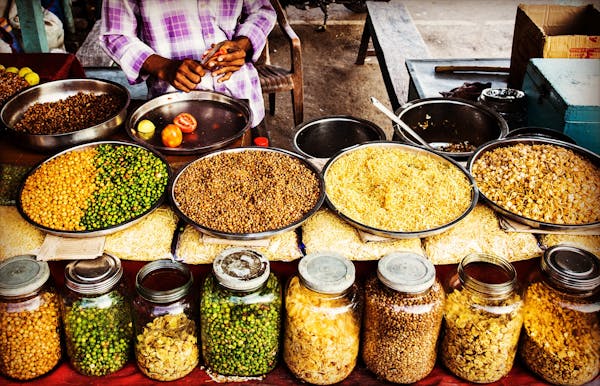A good Asian food market will have a wide variety of foods from different parts of Asia. You can find items from China, India, Japan, Korea, and many more.
You will also find many fresh and frozen foods here that you would not find at your local supermarkets. These include ramen noodles, spring rolls, rice wrappers, and even flour.
Rice
Rice is one of the main ingredients of Asian cuisine. Whether you are looking for jasmine rice, broken rice, brown rice, or noodles, your local Asian grocery store is sure to have it.
White rice, also known as husked and milled rice, is a popular choice in a variety of cooking styles due to its versatility, filling flavors, and subtly sweet taste. It is high in dietary fiber, protein, and vitamin B1, which can help reduce the risk of heart disease and stroke.
The two types of starches found in rice, amylose, and amylopectin, have different properties that contribute to their texture. Amylose is low in digestibility and makes sticky rice, while amylopectin has a higher level of digestibility and helps make risotto-making easier.
Short-grain and medium-grain rice have an oval-shaped kernel with a more pliable, stickier texture than long-grain varieties, owing to their higher amylopectin content. These grains are most often used in Japanese sushi, Korean cuisine, or risotto-making (with short-grain arborio or carnaroli).
Glutinous rice is another type of rice that you may find at your local Asian supermarket. This rice is opaque, has a very low amylose content, and is especially sticky when cooked.
Glutinous rice is found in both the japonica and indica types of rice. It is a great choice for people with digestive problems or those who are looking to lose weight.
Dried Mushrooms
Dried mushrooms are an essential pantry ingredient for home cooks and are a great alternative to fresh mushrooms. They can be eaten year-round and have a rich, earthy flavor that is often used in soups and stews.
The Asian food market is one of the most important markets for dried mushrooms as it offers a wide variety of opportunities to grow this product segment. This market is anticipated to grow at a CAGR of 4.4% over the forecast period.
While dried shiitake mushrooms (Lentinus edodes) are an important staple in the Asian pantry, they must be properly rehydrated before use to ensure their taste and texture are at their peak. Rehydration is simple: soak the mushrooms in hot water for a few minutes, then add them to your recipe.
Despite their long shelf life, it is important to store dried mushrooms in an airtight container. Otherwise, the mushroom's texture and flavor will begin to fade over time.
Dried mushrooms are sold in most mainstream supermarkets in Germany as well as specialized retailers such as Pilze Wohlrab, Niklas, or RPZ. In addition to those companies, independent brand names such as Nasza Chata, Pol Grzyb, Tagros, Lesne Skarby (Forest Treasures), and Fung opal are also represented in the German food market.
Asian Beans
Mung beans are a staple of many Southeast Asian dishes, and their mild nutty flavor is reminiscent of peanuts. They can be eaten raw or used to make delicious soups and stir-fries. They’re also a great source of fiber, which helps regulate your appetite and keep you feeling fuller longer.
Broad beans are another popular ingredient in Asian cooking and can be found in most Asian markets. They can be roasted, salted, or fried for an extra boost of flavor. They are also often steamed for a quick and easy side dish.
Yuchoy is another common vegetable you’ll find in Asian markets. This vegetable is similar to a cucumber and can be peeled or blanched before serving. It’s a good addition to curries and stir-fries or stuffed with meat or seafood.
Daikon radish is another root vegetable that is commonly found in Asian dishes. It can be shredded, pickled, or added to stews and soups like other root vegetables. It’s a bit sweeter and less pungent than most radishes, but it’s still delicious.
Yard-long beans are a relative newcomer to North America, but they’ve quickly become a staple of Asian cuisine. This guide will teach you everything you need to know about these long-legged legumes, including how to buy and prepare them.
Tea
Tea is a big deal in the Asian food market. It is a staple in most Asian households. You can find a wide selection of loose-leaf teas, flavored teas, and even bottled tea. Some of the newest additions to the tea aisle include matcha and green tea, which are both incredibly healthful and tasty.
Other popular beverages include boba tea, yum cha, and bubble tea. The largest selection is found at a grocer's near you. Besides tea, you'll also find a large number of coffees, including Nescafe, Thai rolling, and G7. The best part is that you can buy these products at a fraction of the price you'd pay at your local Starbucks or Dunkin Donuts. The most interesting thing about this aisle is that you'll find a variety of different flavors and sizes, from traditional black tea to exotic matcha. The biggest challenge is choosing which one you like the best!
How to Create Healthy Food Recipes for Busy Weeknights
Asian Beers & Spirits
In Asia, there’s a rich tradition of drinking alcoholic beverages. This is especially true in China, a country where the first alcoholic drinks were brewed more than 9,000 years ago.
The market is highly competitive and brewers must be creative to win over consumers and gain a foothold in the industry. To achieve this, brewers must invest in marketing and product development to ensure that they offer a wide variety of flavors and appeal to all types of customers.
Another key factor to consider is brand reputation. Chinese consumers are very sensitive to the image of a brand and they are only willing to buy products that have a good reputation and a positive online presence.
If you want to sell your products in the Chinese market, you must engage a digital marketing agency that can help you maintain a positive reputation on social media and forums. This will allow you to build trust among your target group and avoid all negative comments from consumers.
As a result, your products will become more popular among the masses and boost your sales. This is a crucial element in the success of your business and one you must not miss out on!
Beer is the most common type of alcoholic drink in Asia. It is a popular beverage for many people in the region, and despite the decline of beer volumes in some markets due to ageing demographics, demand for this drink remains strong in India and Vietnam.
Pork Belly
When sliced, salted, cured and smoked, it turns into the famous salty breakfast staple known as bacon. This fatty, boneless slice of pork is more affordable than other cuts like spareribs and can be used in a variety of dishes.
While the production of pork bellies began on hog farms, it’s now primarily done by large private and corporate operations. These modern hog farms use economies of scale to reduce production costs and offer food manufacturers more affordable cuts of pig meat.
The price of pork bellies is driven by a variety of factors including feed prices, weather and disease. Feeding costs represent more than two-thirds of the production cost of raising hogs. As a result, the supply of hogs can fluctuate dramatically, causing prices to rise and fall.
Another factor that can affect pork belly price volatility is US per capital consumption patterns. The demand for high-protein diets and the popularity of bacon have fueled year-round pork consumption in the United States.
If you’re looking for a way to invest in the market, consider trading pork belly futures or options on the Chicago Mercantile Exchange (CME). You’ll need a regulated broker to do this and it can be a great diversification option if you’re not already invested in other commodities.



